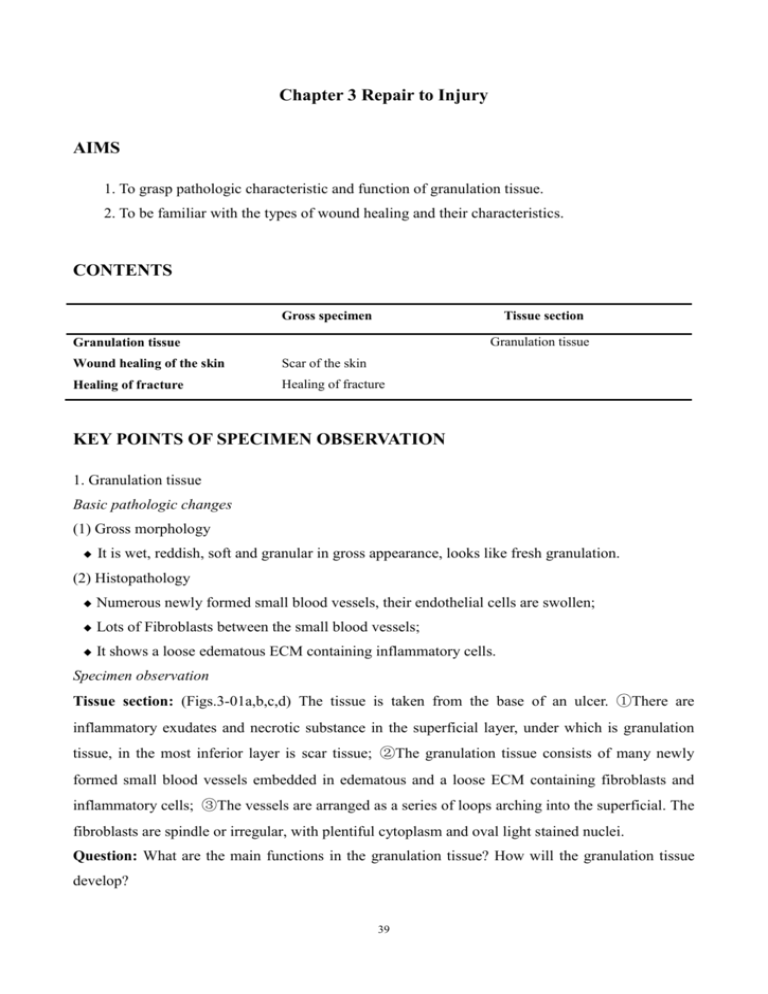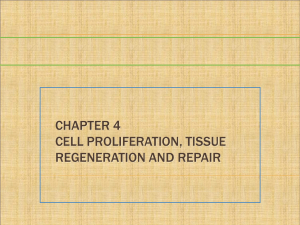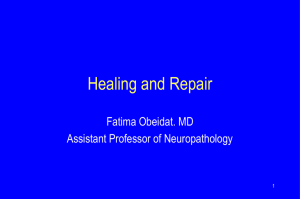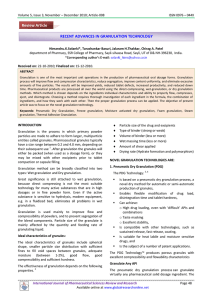Granulation tissue
advertisement

Chapter 3 Repair to Injury AIMS 1. To grasp pathologic characteristic and function of granulation tissue. 2. To be familiar with the types of wound healing and their characteristics. CONTENTS Gross specimen Tissue section Granulation tissue Granulation tissue Wound healing of the skin Scar of the skin Healing of fracture Healing of fracture KEY POINTS OF SPECIMEN OBSERVATION 1. Granulation tissue Basic pathologic changes (1) Gross morphology ◆ It is wet, reddish, soft and granular in gross appearance, looks like fresh granulation. (2) Histopathology ◆ Numerous newly formed small blood vessels, their endothelial cells are swollen; ◆ Lots of Fibroblasts between the small blood vessels; ◆ It shows a loose edematous ECM containing inflammatory cells. Specimen observation Tissue section: (Figs.3-01a,b,c,d) The tissue is taken from the base of an ulcer. ①There are inflammatory exudates and necrotic substance in the superficial layer, under which is granulation tissue, in the most inferior layer is scar tissue; ②The granulation tissue consists of many newly formed small blood vessels embedded in edematous and a loose ECM containing fibroblasts and inflammatory cells; ③The vessels are arranged as a series of loops arching into the superficial. The fibroblasts are spindle or irregular, with plentiful cytoplasm and oval light stained nuclei. Question: What are the main functions in the granulation tissue? How will the granulation tissue develop? 39 2. Wound healing of the skin Basic pathologic changes (1) First intention healing ◆ A regular, small scar is formed in the incision of the skin. Microscopically, the epidermis is thin under which small quantities of collagen fibers deposit. (2) Second intention healing ◆ A big, irregular scar is formed in the incision of the skin. Microscopically, hyaline degenerated collagen accumulates. Specimen observation Case abstract: A 30 year-old female received a caesarean operation one year ago, the operation was healed up well. Half a year later, she felt pain on the incision where became harden and stiffen, and a sclerosis nodule could be touched. The pain was related with menses, the lesion was diagnosed as endometriosis and was incised by operation. Gross specimen: (Fig.3-02) There is a linear scar of operation in the center of the skin, it is about 5cm in length, and is nicely coapted. The color and luster is lighter than the surrounding normal skin’s. 3. Healing of fracture Basic pathologic changes (1) Hematoma formation. (2) Provisional fibrous callus and cartilage formation. (3) Bony callus formation. (4) Bony callus remodeling. Specimen observation Gross specimen: (Fig.3-03) The middle of the long bone appears fushiformis expansion where a fracture line crossing over the center. Surrounding, callus is formed by gray-white fibrous tissue and light yellow osseous tissue. The focal expansion is due to the formation of callus. On the cut surface, the tissue of new bone is dense without medullary cavity formation. It is bony callus phase. CASE DISCUSSION Clinical case 40 Case abstract. A 32-year-old man, he was given a mending operation for gastric ulcer perforation, 10 days later, most of the incision on the abdominal skin appeared as a liner scar, but the distal tissue defects 2 cm in length was filled with granulation tissue, which protruded above the skin and was covered by yellowish-white exudates. The granulation tissue was excised for several times and left a large scar there. Discussion 1. Which factors impede the healing of the skin incision? 2. Which sequels could be caused by delaying in the healing of skin incision? How to prevent and deal with? PRACTICE REPORT 1. To illustrate the granulation tissue and describe its structural features. 2. To compare the difference between wound healing of the skin and healing of fracture. DISCUSSION 1. What are the conditions and features of first intention healing and second intention healing? 2. What are the functions of the granulation tissue in wound healing? 3. What are the factors influencing wound healing? (Kunming Medical University Cui Jin, Zhou Yingying, Hua Hairong) 41









